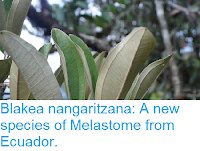The Miombo woodlands are a wetland, open-forest ecosystem dominated by leguminous Miombo Trees, Brachystegia spp., which covers about 10% of the total land area of Africa. They are found at altitudes of between 1000 and 2500 m, in areas where more than 1000 mm of rain is experiences annually, with a distinct vegetation, growing on alluvial soils along river plains and in areas of extended wetlands. These woodlands are the dominant vegetation of Angola, Zambia, Tanzania, Malawi, Mozambique and Zimbabwe, and cover areas of several other Southern and Central African countries. They are home to about 75 million people, with a further 25 million urban dwellers estimated to be dependent on them for food and fuel, something which places considerable strain on this ecosystem, with areas of woodland increasingly depleted for charcoal.
In a paper published in the journal PhytoKeys on 3 July 2017, Marie Claire Veranso-Libalah of the Department of Botany and Plant Physiology at the University of Buea, and the Institut für Molekulare Physiologie and Institut für Organismische und Molekulare Evolutionsbiologie at the Johannes Gutenberg-Universität Mainz, Robert Stone of the School of Life Sciences at the University of KwaZulu-Natal, and Gudrun Kadereit, also of the Institut für Molekulare Physiologie and Institut für Organismische und Molekulare Evolutionsbiologie at the Johannes Gutenberg-Universität Mainz, describe a new species of herbaceous Melastome from the Miombo woodlands of southwestern Tanzania and central Angola.
Melastomes (Melastomataceae) are broad-leaved flowering plants found across the tropics, and occasionally elsewhere. They are related to Pomegranates, Myrtles and Evening Primroses. Melastomes can be herbs, shrubs or small trees. Some members of the group have become notorious invasive species, notably Koster's Curse (Clidemia hirta) a shrub native to Central America and the Caribbean that has become a pest species in Hawaii, Australia, Sri Lanka and parts of Africa, and the Bush Currant (Miconia calvescens) a small tree from Central and South America, which is regarded as one of the world's most invasive species, forming monospecific stands that have replaced 25% of the surviving rainforest on Tahiti.
Melastomes (Melastomataceae) are broad-leaved flowering plants found across the tropics, and occasionally elsewhere. They are related to Pomegranates, Myrtles and Evening Primroses. Melastomes can be herbs, shrubs or small trees. Some members of the group have become notorious invasive species, notably Koster's Curse (Clidemia hirta) a shrub native to Central America and the Caribbean that has become a pest species in Hawaii, Australia, Sri Lanka and parts of Africa, and the Bush Currant (Miconia calvescens) a small tree from Central and South America, which is regarded as one of the world's most invasive species, forming monospecific stands that have replaced 25% of the surviving rainforest on Tahiti.
The new species is placed in the genus Argyrella, which currently contains six species from across Sub-Saharan Africa, and given the specific name richardsiae, in honour of Mary Alice Eleanor Richards (1885-1977), a British botanist who collected plants extensively across a wide area of Africa between 1951 and 1974. It is an erect herbaceous plant, reaching about 1 m in height, branching at each node, with blade-shaped leaves and inflorescences with 5-10 pink or mauve flowers each.
Argyrella richardsiae, (A) habit (B) glandular trichomes (C) leaf (D) flower (E) stamens: inner stamen (left), outer stamen (right) (F) seed. Doris Franke in Veranso-Libalah et al. (2017).
The species was found in Mpanda District in Tanzania and Huambo Province in Angola, and is thought likely to also be present in the southern wetlands of the Democratic Republic of Congo and Malawi and the northern part of Zambia. However, in all of these areas the Miombo woodlands are threatened by Human activities, particularly charcoal production, and for this reason Veranso-Libalah et al. consider that Argyrella richardsiae should provisionally be considered to be classified as Endangered under the terms of the International Union for the Conservation of Nature’s Red List of Threatened Species.
See also...
Follow Sciency Thoughts on Facebook.







